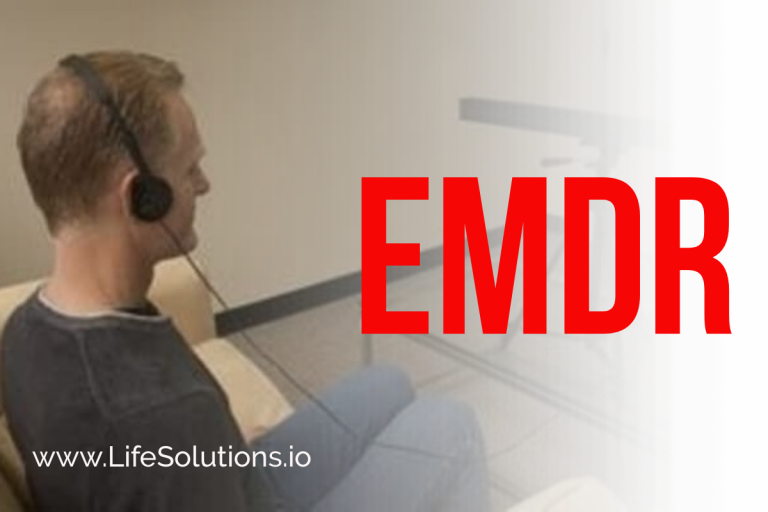What is EMDR?
EMDR (Eye Movement Desensitization and Reprocessing) is a psychotherapy that gained worldwide recognition as an effective treatment of trauma. It was initially developed to help people recover from PTSD (Post-traumatic Stress Disorder) but has since been used to enable people to heal from the symptoms and emotional distress that are the result of disturbing life experiences. Therapists have been using this therapy to help people with symptoms of anxiety, depression, obsessive-compulsive disorder, eating disorders, addiction, nightmares, and flashbacks.
EMDR therapy has been extensively researched and has demonstrated effectiveness in treating the “everyday” memories that are the reason people have low self-esteem, feelings of powerlessness, and all the myriad problems that bring them in for therapy. Over 100,000 clinicians throughout the world use the therapy and millions of people have been treated successfully over the past 25 years.
Heal With EMDR
“Our brains have a natural way to recover from traumatic memories and events. This process involves communication between the amygdala (the alarm signal for stressful events), the hippo-campus (where safety and danger memories are created and stored), and the prefrontal cortex (which controls behavior and emotion). Some events are so upsetting that the normal communication between these areas becomes blocked and cannot be processed without help. This stress response is part of our natural fight, flight, or freeze response. When distress from a disturbing event remains, the upsetting images, thoughts, and emotions may create feelings of overwhelm, of being back in that moment, or of being “frozen in time.” EMDR therapy helps the brain process these memories and allows normal healing to resume. The experience is still remembered, but the fight, flight, or freeze response from the original event is resolved.”
EMDRIA (EMDR International Association)

What is EMDR Used For?
- PTSD
- Trauma and Abuse
- Addiction
- Eating disorders
- Panic Attacks
- Dissociative disorders
- Depression and bipolar disorder
- Sleep disturbance
- Anxiety
- Flashbacks
- Phobias
- Domestic Violence
- Chronic Illness and medical issues
- Sexual assault
- Grief and loss
- Personality disorders
What Is Trauma?
Trauma is any event (or events) that cause emotional distress to someone. It could be a natural disaster, a car accident, combat, going through a physical illness and medical treatment, losing a loved one, a divorce, a breakup, moving to a different country or place, and especially being exposed to verbal, emotional, physical, or sexual abuse.. Trauma can be a one-time event, a prolonged event or a series of events. Trauma that affects a community or a country is called collective trauma.
A lot of people avoid dealing with traumatic memories because it brings up a lot of pain for them to talk about it. Sweeping them under the rug usually causes more harm than good. Sooner or later, those traumas will bubble to the surface and cause even more distress. EMDR can help clients process memories, without being re-traumatized. to reduce distress and create more helpful, functional beliefs and coping strategies.
Traumatic events can cause injury to a lot of different systems:
- Trauma affects ability to process thoughts and make good judgments.
- Trauma causes emotions of shame, guilt, fear, anger and pain’
- Trauma affects muscles, joints, digestion and metabolism, temperature, sleep, immune system, etc.
- Trauma affects our worldview, the lenses with which we see reality (typically so we see it as unsafe), our understanding and meaning of life, society, and the world.
- Trauma affects relationships with spouses, family, friends, colleagues and strangers
EMDR Treatment
EMDR therapy is an eight-phase treatment.
In the beginning phases, we prepare for the in-depth processing by going over a detailed history of distressing thoughts, memories, and feelings. We also use mindfulness exercises to prepare for any emotional distress that may come up during treatment. Once we have the foundation ready, we can get into processing. After the clinician has determined which memory to target first, he asks the client to hold different aspects of that event or thought in mind.
The clinician then use bilateral stimulation such as eye movements, hand-held pulsers, or audio stimulation.
Eye movement is done by following the clinician’s finger, a wand, or a light bar side to side. According to a Harvard researcher, this procedure causes biological mechanisms in the body, that is involved in Rapid Eye Movement (REM) sleep, to connect with internal associations of disturbing memories, beliefs, and feelings. It is also said that EMDR is so effective because the bilateral stimulation (eye movement, pulsing, or audio) overloads the working memory, and in the process it disrupts or loosen the memory material that was rigidly and dysfunctionally stored.
In successful EMDR therapy, the meaning of painful events is transformed on an emotional level. The insights clients gain in EMDR therapy result from the client’s own accelerated intellectual and emotional processes. After the client’s level of disturbance has decreased, a more helpful belief is installed to replace the negative one. An example of this might be someone who believes that they are not safe, installing a more helpful belief that they are no longer in those circumstances and that they are indeed safe now.
Once the more helpful belief is installed, we check for any leftover distress (sometimes people report physical symptoms, such as tightness in their muscles) and focus on that to relieve symptoms associated with the distressing memory or thought. We want to make sure your brain is “unstuck” so we can move forward.
The goal is that clients who conclude EMDR therapy would feel empowered by the very experiences that once debased them. As a natural outcome of the EMDR therapeutic process, the clients’ thoughts, feelings and behavior are all indicators of emotional health and resolution.

Organizations Recommend EMDR
EMDR therapy is recommended as an effective treatment for PTSD and other trauma and stressor disorders by the following organizations. These treatment guidelines are based on reviews that evaluate research of established evidence-based mental health treatments.
- American Psychiatric Association. (2004). Practice guideline for the treatment of patients with acute stress disorder and posttraumatic stress disorder.
- Department of Veterans Affairs & Department of Defense. The Management of Posttraumatic Stress Disorder Work Group. (2017).
- International Society for Traumatic Stress Studies. (2018).
- Substance Abuse and Mental Health Services America. (2012). SAMHSA’s National Registry of Evidence-based Programs and Practices.
- The Cochrane Database of Systematic Reviews. (2013). Psychological therapies for chronic post-traumatic stress disorder (PTSD) in adults.
- World Health Organization. (2013). Guidelines for the management of conditions specifically related to stress. Geneva: WHO.
EMDR is also found effective by the United Kingdom Department of Health, Australian Centre for Poast-traumatic Mental Health, Dutch National Steering Committee for Health Care, Israeli National Council for Mental Health, and many other international health and governmental agencies.

EMDR Research
- More than 30 positive controlled outcome studies have been done on EMDR therapy. Some of the studies show that 84%-90% of single-trauma victims no longer have post-traumatic stress disorder after only three 90-minute sessions.
- Another study, funded by the HMO Kaiser Permanente, found that 100% of the single-trauma victims and 77% of multiple trauma victims no longer were diagnosed with PTSD after only six 50-minute sessions.
- There has been so much research on EMDR therapy that it is now recognized as an effective form of treatment for trauma and other disturbing experiences by organizations such as the American Psychiatric Association, the World Health Organization and the Department of Defense.
Brief Therapy
EMDR therapy is done without speaking in detail about the problem or doing homework that is used in other therapies. For this reason EMDR produces results in a much shorter time than other therapies.
Repeated studies show that by using EMDR therapy people can experience the benefits of psychotherapy that once took years to make a difference. It is widely assumed that severe emotional pain requires a long time to heal. EMDR therapy shows that the mind can in fact heal from psychological trauma much as the body recovers from physical trauma.
That said, every person is different and results may vary depending on the client and the circumstances. EMDR is not a magic bullet, and an experienced clinician will never rush the process in case some important underlying issue is missed. Some clients have years of compound trauma which may take some time to work through, and a wise clinician will move at a rate that is safe and comfortable for the client.
EMDR therapy demonstrates that the brain’s information processing system naturally moves toward mental health. If the system is blocked or imbalanced by the impact of a disturbing event, it can cause intense suffering. The clinician will help the client to remove the block and activate their natural healing processes, by using the protocols and procedures of EMDR therapy.
Are you interested to hear more about EMDR therapy? Click on the link below to contact Heleen for a free 15 minute phone consultation.